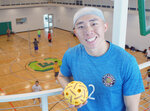
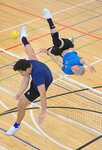
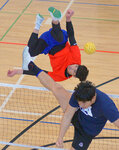
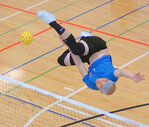
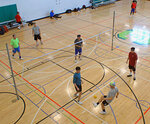

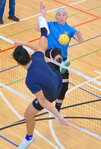


Gao Chang likes to play volleyball and soccer. But the sport that has captured his heart is sepak takraw, a game with three team members on each side of a net using any part of their body except their hands to get a synthetic plastic ball over the net.
Chang started playing in a refugee camp in Thailand when he was 11. “As young kids, we watched our older brothers play, and we would jump in just for fun,” he said. “Later on I got to love the sport.” So much so that he founded Sepak Takraw of USA (STUSA) in St. Paul in 2014 with Xai Tsa Pha. “From there we recruited Lee Pao Xiong and Txiabeng Vang. We started here, but cover the whole USA.”
The origins of the game go far back in history. “There are two stories of where it started,” Chang said. “One story is that Chinese soldiers started kicking a ball made of bamboo and chicken feathers back and forth. In the early 1900s teams were formed with a net. Another story says the origins were in Malaysia.”
Two gold medals
Last year Chang received an invitation from the International Sepak Takraw Federation to put a team together and participate in the World Cup in South Korea. He had a month and a half to put a team together.
“I talked to the president and vice president of our organization, and they said we should do it. I called Jeremy Mirken, a board member, and we started preparing to get a team together. These were all good, skilled players from Texas, California, Iowa, Nebraska, Indiana and Minnesota.”
Two weeks before their departure for South Korea, the team played together for the first time at a tournament Chang put on in St. Paul. “We put people in their positions, and with Jeremy as coach, we went to South Korea in November. We won gold in two divisions. It was an honor and a good experience to play against other countries.”
Countries participating included Germany, Vietnam, Singapore, Malaysia, South Korea and Japan.
how the game is played
Chang said that for international competition, the game can be played with teams of two, three and four. Teams also can play coed. He said the balls kicked back and forth in sepak takraw are the original black-lined one, which is harder but lasts longer. There is a very soft purple ball for kids, a softer red ball for female players, and a yellow ball for males. The yellow ball is usually used in tournaments.
In a typical three-member team, there is a server who gets the first ball, a feeder who feeds the ball and a spiker who kicks the ball over the net. The ball can be touched three times with the feet, knees, chest or head of a player. If the ball touches the hand or arm, it is considered handball.
Watching the game in action, aspects of soccer, volleyball, badminton and hackey sack come to mind. Chang said if a player is good enough, he can keep the ball to himself before sending it over the net, but that is considered a selfish form of play.
“Spiking skill takes time,” Chang said. “Flexibility is number one. It takes a long time of practice. When I was younger, I did spiking. There are many out there who can do all kinds of tricks, and are very talented.”
Spikers can leap in the air, kick the ball over the net and fall to the floor, only to bounce up right away ready to play. But Chang said there are a lot who do get injured. “Some land in the wrong position and can get a sprained ankle or injure their shoulder,” he noted. “If you don’t land properly, you can injure any part of your body. But if you train you won’t get injured.”
Chang said players can train for spiking by kicking at a hanging ball. “You can start kicking from a lower level and adjusting the ball higher. That is how you train for spiking,” he said. “For serving, you start on a lower level and go up.”
It can be played anywhere
According to Chang, sepak takraw can be played anywhere. “In the refugee camp, we played on dirt,” he said. “It can be played outside in the park, on grass. Or indoors on a court.”
He said there are outdoor courts in the area. “In summer, we practice almost every night at the court at Duluth and Case. That place is always packed.” Chang said there are also two courts at Marydale Park and the Frogtown Community Center (230 Como Avenue). Rice Rec Center at 1021 Marion also has courts. Over the winter, some players cleared the snow and were playing outside the Frogtown Community Center.
The game has no age limits. Many people in their 70s play the game for exercise. Chang said professionally, the best age is between 18 and just under 30. “They have more energy, but in the real world, anyone can play.”
There are limited rec centers in the Twin Cities where the game is played, but Chang said the organization is recruiting females to join the team. Although the current players are all Southeast Asian, he said he hopes the sport will bring in everyone. “If we got some 6-foot players, since the net is set at 5 feet, that would be great for us,” he said.
Chang is stepping down as secretary of the Sepak Takraw of USA group, but he will continue coaching teens. As a deputy sergeant for the Ramsey County Sheriff’s Department, he coaches youth in sepak takraw. “It is part of our youth program and crime prevention unit,” he said. “We see car jackings and auto theft, and we don’t want that. We just want to make sure the kids get along with law enforcement. And hopefully when these kids grow up they can participate internationally.”
Chang is excited at the possibility that sepak takraw may be introduced as an Olympic sport in the 2026 Summer Olympics.
One thing he is hoping for is that the St. Paul Parks and Rec Department and the City of Saint Paul can add additional light poles at the courts at Case and Duluth so that people can play until 11 p.m.
“Some work and come late, so they don’t have that long to play,” Chang said. “We already applied and got rejected by the mayor, but this is for the whole community.”
Comments
No comments on this item Please log in to comment by clicking here